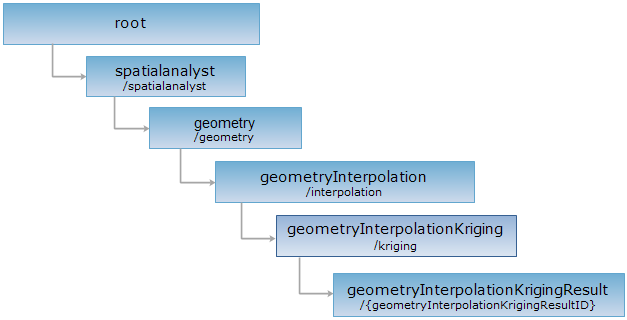
<geometryInterpolationKriging_uri>/{geometryInterpolationKrigingResultID}[.<format>]
The interpolationKrigingResult resource used to get the results of a Kriging interpolation analysis.
Supported Methods:
Supported output formats: rjson, json, html, xml.

Implement the HTTP request on the following URI, where supermapiserver is the server name, with rjson being the output format.
http://supermapiserver:8090/iserver/services/spatialanalyst-sample/restjsr/spatialanalyst/geometry/interpolation/kriging/fvmhhtsg_ae18346abd1f449b9a8947252c5f10e2.rjson
Gets the result of a Kriging interpolation analysis.
The response code would be 200 in a normal situation.
| Field | Type | Description |
| succeed | boolean | Whether the interpolation analysis is successful. |
|
message |
String | The message returned while the interpolation analysis failed. |
| dataset | String | The identifier of the result dataset. |
| recordset | Recordset | The result recordset used to store spatial object information. |
Suppose we implement the GET request on the result resource of implementing the POST request on the geometryInterpolationKriging resource: http://localhost:8090/iserver/services/spatialanalyst-sample/restjsr/spatialanalyst/geometry/interpolation/kriging/fvmhhtsg_ae18346abd1f449b9a8947252c5f10e2.rjson, the returned rjosn format representation would be as follows:
{
"dataset": "kriging@Interpolation",
"message": null,
"recordset": null,
"succeed": true
}
Asks for the response identical to the one that would correspond to a GET request, but without the response body. This is useful for retrieving meta-information written in response headers, without having to transport the entire content. The meta-information includes the media-type, content-encoding, transfer-encoding, content-length, etc.
HEAD request can be used to check if the geometryInterpolationKrigingResult resource exists, or if the geometryInterpolationKrigingResult resource can be accessed by clients. It can also determine if the geometryInterpolationKrigingResult resource supports an output format <format> if performed on a URI with .<format> included.